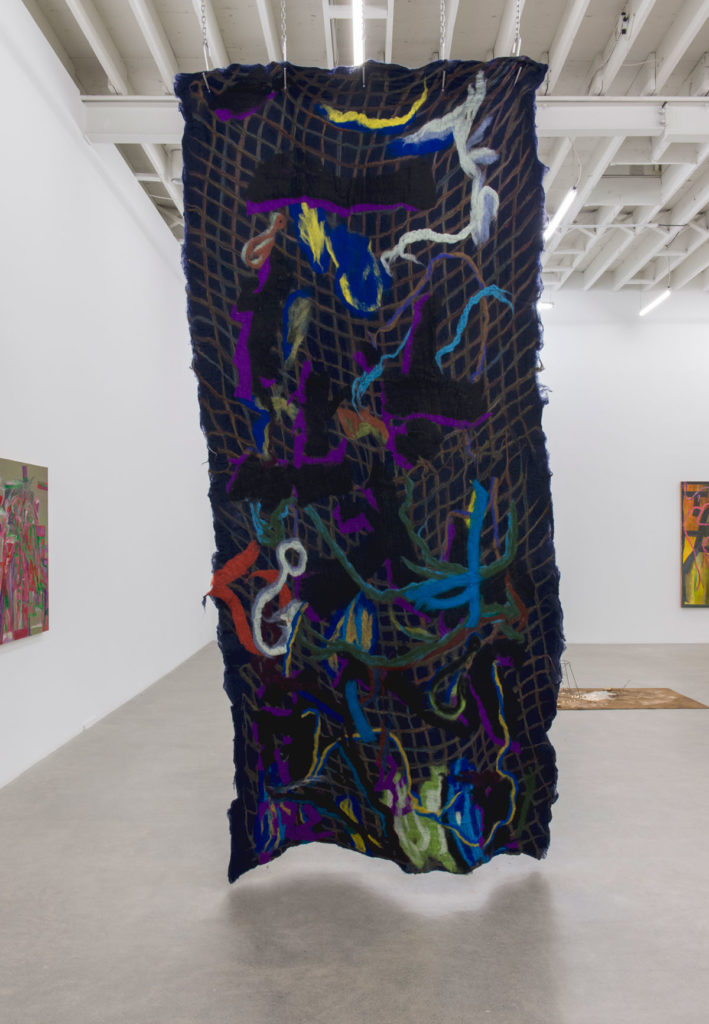A search on my facial features in Google Arts & Culture’s database of museum collections returns a self-portrait by Tullo Moy from the Accademia di Belle Arti di Belogna, with an unsuitable sweep of hair, but the same dark eyes and subtle nose hump. In another photo, in profile, looking left, I’m a match for a 1949 self-portrait by Edwin Dickinson, with gleaming forehead and high cheeks, from the collection of the National Academy of Design in New York.
Though it’s jarring to find oneself without a network signal, whether in a remote locale or an underground parkade, it’s also unsettling to live in a time with instantaneous answers, of varying accuracy, to each obscure or worrying question. Which museum portrait do I look like? How rare is this old penny? Will I die from this previously unnoticed freckle? There’s a certain potentiality upheld by not knowing every detail, as recent Vancouver exhibitions suggest.
Hovering near recognition, “Nature,” a group show at Catriona Jeffries, features sculptural and wall works by Rebecca Brewer, Rochelle Goldberg, Charmian Johnson and Christina Mackie. The accompanying text proposes the exhibition as a conceptual refuge, and reflects a consideration of nature as inclusive of the products of human activity. Peppered with organic forms, earthy matter and traces of investigation, the works articulate and generate wonder.
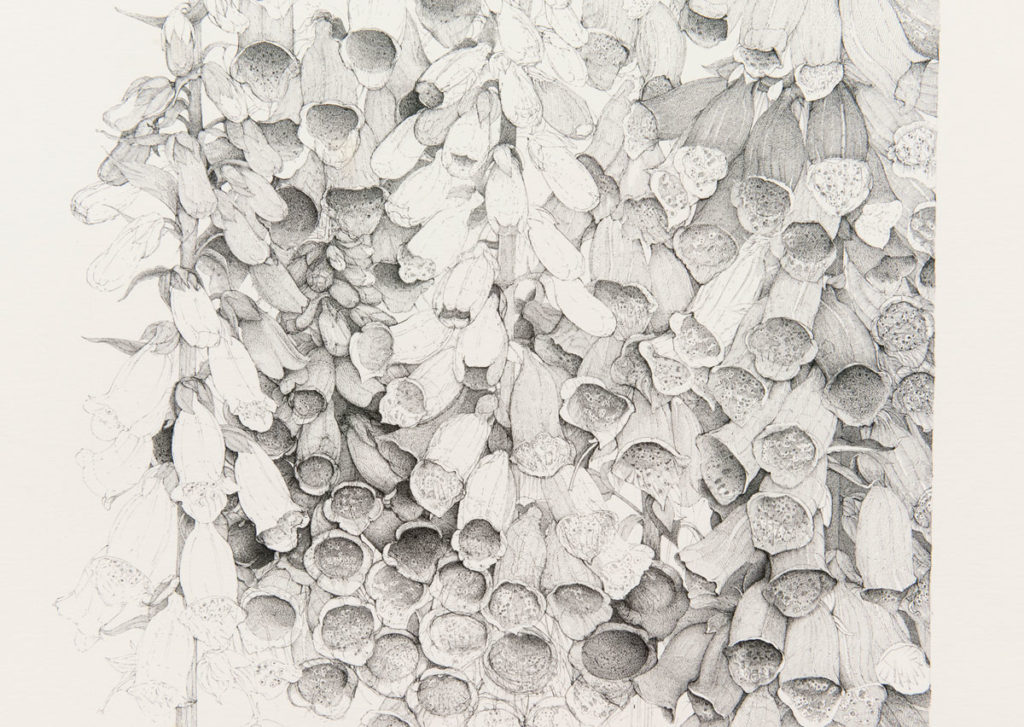
Charmian Johnson’s ink on paper drawings anchor the exhibition—in a cluster placed at the entrance to the gallery, reaching for others dispersed across the room, they mark the perimeter of the space. Each presents intricate florals in black and white, ranging in style from scientific illustration to graphic motif. The flowers themselves convey careful observation, but the arrangements are constructions—unlikely views that imply movement or time-lapse, with mirrored, or intersecting formations.
The exhibition text ties Johnson’s works to places and eras—Tangiers in the 1970s, Hawaii in the 1980s, Vancouver sometime after—and lists them without titles. Their corresponding dates follow an inconsistent format, reflecting a casual uncertainty, as though extracted from passing conversation—“1988,” “1990s–2017,” or “completed 2018.” While uniform in thin white frames, the drawings resist exact chronology, contrasting their visual rigidity with playful imprecision.
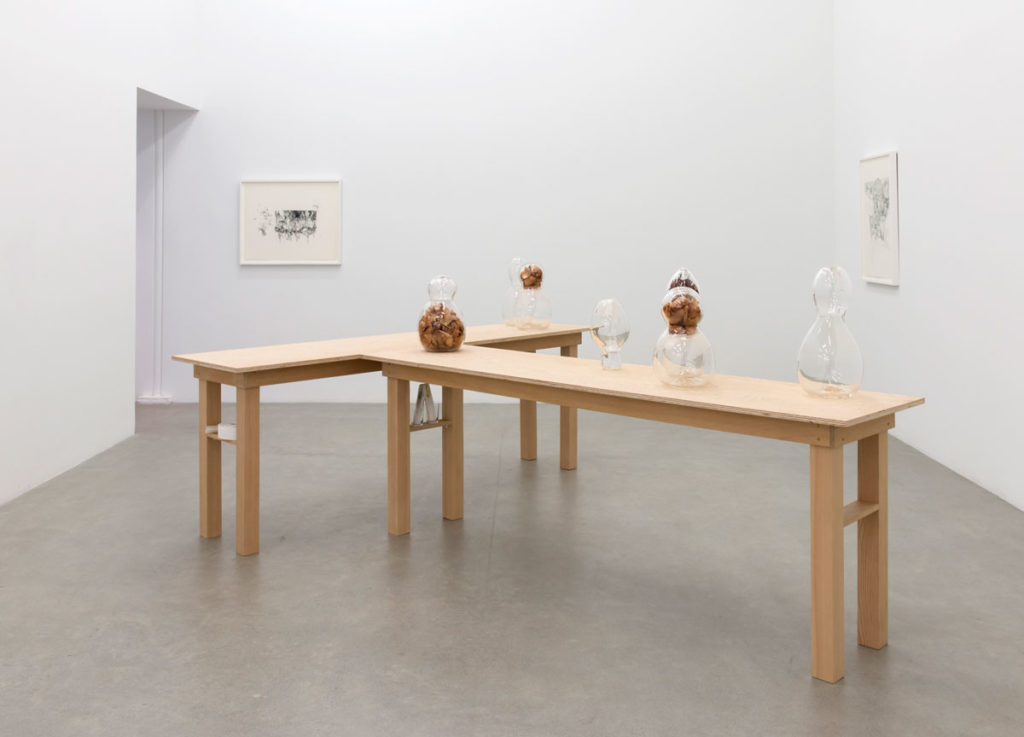
Through allusions to alchemy, Christina Mackie’s Ambic (2014) implies an unseen outcome. Two perpendicular plywood tables hold blown glass vessels that evoke distillation processes. Several of their bulbous shapes are packed with gathered elements—madrona (a.k.a. arbutus) bark, and dried onionskins—sealed within layers of parafilm, a paraffin wrap used in laboratories. Below the table, tucked into its trestles, is a roll and individual samples of chromatography paper, used to separate coloured chemicals or substances.
Were it not impossibly clean, with a pristine fir veneer, one might mistake the sculptural tabletop for a workspace serving a preparatory function. Instead it becomes an arranged display of an obscure process, perhaps fantastic or mundane, protected within these gallery conditions like specimen under a bell jar.

This orderliness is countered by Rochelle Goldberg’s Introlocutor: can you trigger the switch? (2018)—an erratic mix of chia seeds, shellac and paint that encrusts conjoining swaths of thin polyester carpet, laid directly onto the gallery floor. Atop of this layer is the armature of a lamp shade and two disintegrating light switch casts, each wired to delicate strands of glowing LED lights. The installation is further complicated by a scatter of dried celery roots, brass matches, and a steel stand that extends upward, hoisting an effigy-like sculpture formed with glazed ceramic segments.
The handout includes Talking Points (2018), Goldberg’s short text written as lines of dialogue. One reads: “She wants to think about what we as humans are touching, and have touched, and will touch, and how that has changed and how that will continue to change.” The withered states of Goldberg’s once-tactile elements echo this phrase, reminiscent of the squish of damp clay, the flick of a switch, or the strike of a match.
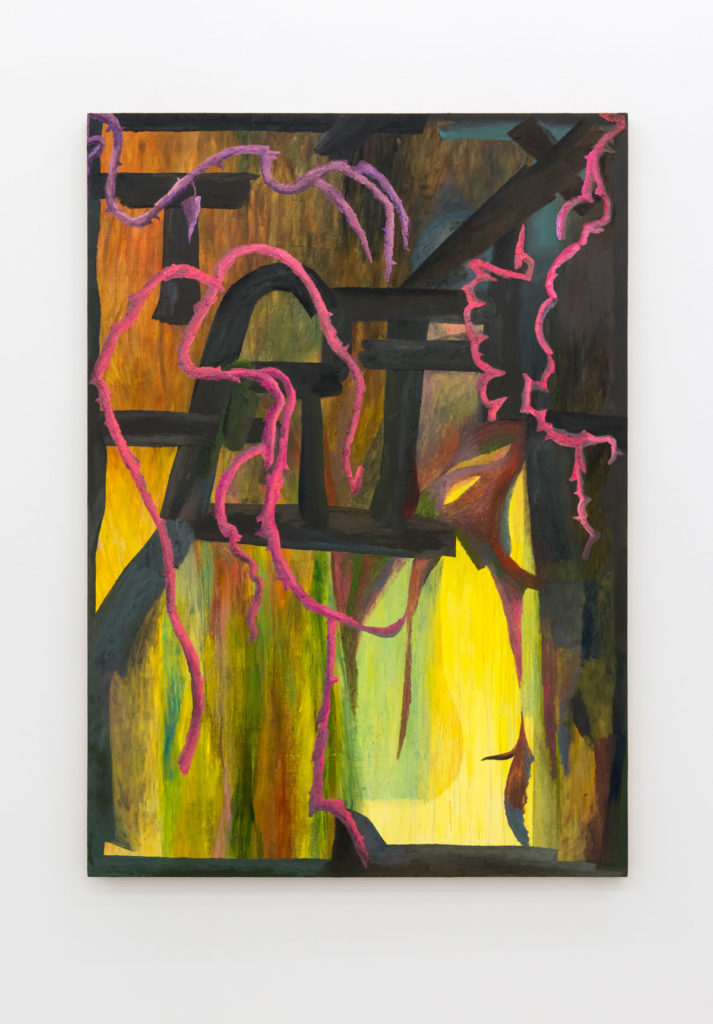
Rebecca Brewer’s Silent Running (2018) is a two-sided, felted wool composition that hangs from the ceiling, centre gallery. From its more colourful side, vibrant purple shapes line the edges of black shadows, while blue, yellow and seaweed hued lengths wiggle and twist over a uniform grid. The grid itself, like the glowing perspective lines of 1980s retrofuturism, projects a space beyond its surface. On its reverse, subdued pastel forms peek from underneath a second grid, this one reading as a containing web—like a catch-all bounty by way of drift net fishing.
Brewer’s dual composition communicates factors of its material and method. Works in this series require large outdoor spaces yet, once dry, are light and hardy. They are created at her parents’ home in Nanoose Bay then folded and transported via passenger ferry. Materially, the wool is a departure from her established painting practice while consistent with its forms. “Nature” also includes Brewer’s oil on panel works Flower Dumpster (2018) and Whole Body Organizing (2018), each winding and angular like vines on trellis. Inverting her painting processes, Brewer builds the felted images in reverse, accounting for fluid shifts while working toward a final outcome through a cloak of hazy imprecision.
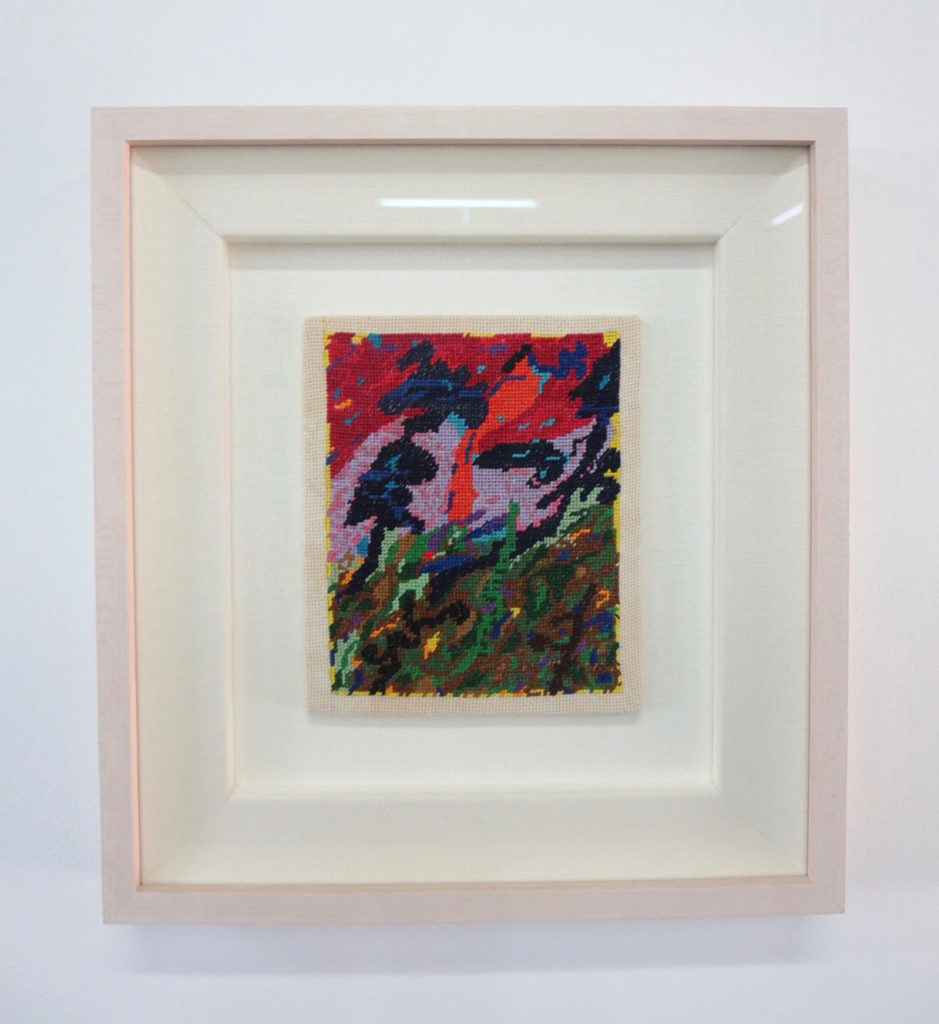
Across the alley at Chernoff Fine Art is “A Motion for a Notion Commotion,” a solo exhibition by Les Ramsay, featuring framed needlepoints alongside two stretched fabric assemblages. A longtime collector of found embroidery, Ramsay has recently incorporated selections into his larger textile compositions and, beginning in summer of 2016, has produced his own stand-alone needlework. This exhibition, too, represents a material departure, nudging the artist from a long-established studio practice of painting and assemblage into new territories.
Though the works convey Ramsay’s technical skill (practiced measures are required for proper stitch tension) he forfeits mastery, distorting straight pattern lines with deviations remindful of digital glitch. Be Kind, Rewind (Sampler 1) (2017) presents his version of the trope of historic needlework samplers often taken up as skill-building exercises. It features the artist’s name and the English alphabet, with an added slogan borrowed from outmoded video rental stores.
Other compositions revisit the abstracted forms introduced by Ramsay’s prior works, here given new or expanded titles, such as To That Land of Gentle Breezes Where the Peaceful Waters Flow (Snowbird Revisit) (2017). The portability of embroidery lends itself to movement, and many of these were produced in the Vancouver outdoors this summer and fall, while Ramsay was healing with a broken foot. I want to see the landscapes of my own meandering reflected in his abstracted swoops and contours—the sunset at Hadden Park Dog Beach or the green leaves of Strathcona Community Garden. Maybe I do.
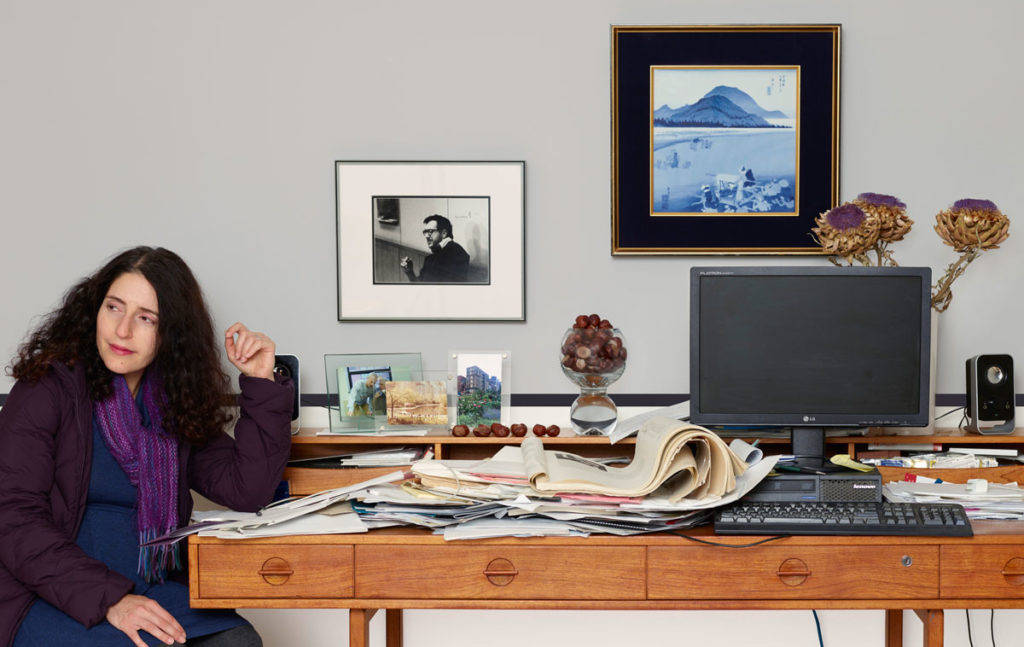
My last stop is CSA Space, located above Pulpfiction Books on Main Street. To gain access to the modest and quiet gallery, you exchange your driver’s license for the key, kept near the register of the much loved book shop (I thoroughly enjoy this ritual). The solo exhibition by Kevin Madill, titled “Vancouver Through Portraiture,” consists of three large digital composites, excessively detailed and mounted unframed, allowing for a close-up inspection of minutiae.
In Visite d’atelier: Portrait de Shirin Eshghi: Une femme dans un paysage d’hiver (2016), the photo’s namesake, Head of Asian Library at UBC, sits at the edge of a disorderly computer desk. An eclectic mix of imagery personalizes the office space, including vases of chestnuts and dried flowers, and framed portraits. The faces in these snapshots don’t inspire my recognition, but I find familiarity in a stack of expired TransLink passes overflowing from a wooden file tray.
In a statement on the work included in the guide, Madill describes it as a merging of three genres—portrait, still life and landscape—based on Edgar Degas’ Portrait de Madame Paul Valpinçon (1865). Eshghi and Valpinçon both gaze sideward, one elbow on their respective tables, with their fingers softly curled. Madill acknowledges the wave of papers blowing across the desk and keyboard as comprising the added wintery component listed in his image’s title. I see it more clearly in the dark monitor screen, showing faint smudges of cleaning residue, like ice crystals over a cold, still lake. Either way, it’s a beautiful metaphor.
Lucien Durey is an artist and writer based in Vancouver.

